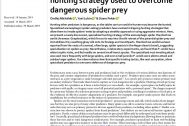Obsah
Hunting other predators is dangerous, as the tables can turn and the hunter may become the hunted. Specialized araneophagic (spider eating) predators have evolved intriguing hunting strategies that allow them to invade spiders’ webs by adopting a stealthy approach or using aggressive mimicry. Here, we present a newly discovered, specialized hunting strategy of the araneophagic spider Poecilochroa senilis (Araneae: Gnaphosidae), which forces its way into the silk retreat of the potential spider prey and immobilizes it by swathing gluey silk onto its forelegs and mouthparts. Poecilochroa senilis has been reported from the nests of a several, often large, spider species in the Negev desert (Israel), suggesting specialization on spiders as prey. Nevertheless, in laboratory experiments, we found that P. senilis has a wider trophic niche, and fed readily on several small insect species. The specialized nest-invading attack was used more frequently with large spiders, and even small juvenile P. senilis were able to attack and subdue larger spiders. Our observations show that specific hunting tactics, like nest usurpation, allow specialized predators to overcome defences of dangerous prey.



